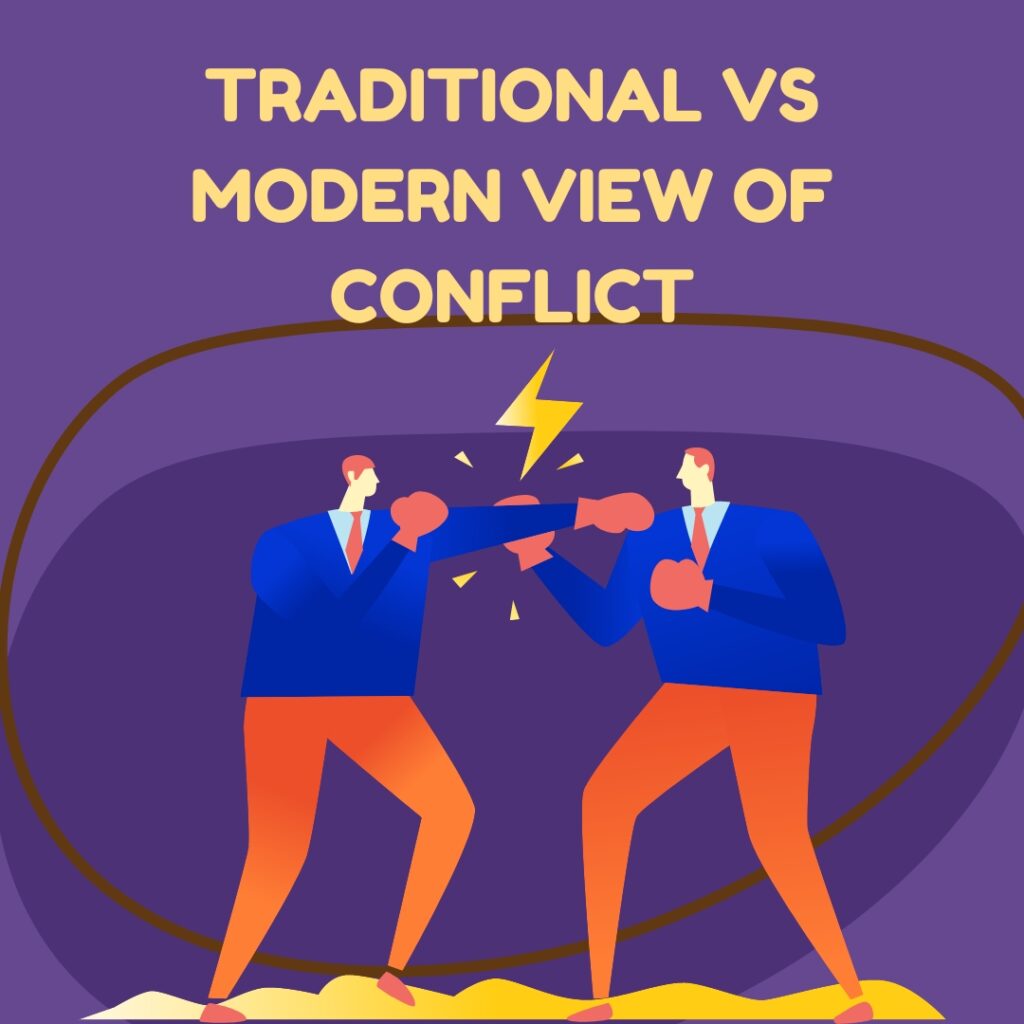
Traditional Vs Modern View of Conflict has taken a center stage in the resolution of conflict in the workplace. Understanding both these approaches are critical in the evolution of a manager’s thought process on how to resolve the same. Steve Jobs was one of the pioneers and created a modern-day conflict while developing his revolutionary iPhone
Traditional Vs Modern View of Conflict
What is a traditional view of conflict?
It was believed that conflict was destructive, not beneficial, and unfavorable, and it was never thought that conflict was beneficial to the organization. It was believed to be one of the reasons for the breakdown in the organization, which had a negative impact on the relationship between management and employees, and even created communication barriers, meaning that it was difficult to clarify the differences between individual interests and the interests of the organization as a whole. It was believed that if there hadn’t been any conflict within the organization, it would have been able to operate in the most optimal and cohesive manner possible.
The traditionalist advocated for a resolution to the conflict that was very simple. According to them, any kind of conflict is detrimental to the organization and must be avoided at all costs. This can be accomplished by determining the factors that contribute to conflict and then removing those factors from the equation. Understanding the traditional view is critical for developing our insights on Traditional Vs Modern Views of Conflict.
What is the meaning of the modern view of conflict?
The current viewpoint on conflict within an organization is that it is desirable; however, the extent of conflict within the organization ought to be controlled so that it does not result in negative consequences. When an organization offers very little room for rewards in the form of status, responsibility, or power, and when, on the other hand, employees have the instinct to achieve more perks and benefits, conflict may also result. According to the interactionist point of view, if there is harmony, peace, and cooperativeness within an organization for an extended period of time, employees will always remain in their comfort zone, and they will never respond to the innovation and change that is taking place within the organization.
It is desirable to have a minimum amount of conflict if one wants employees to be creative and self-critical, as well as to get them out of their comfort zones. The interactionist viewpoint holds that the primary objective of any organization should be to perform and achieve its goal, not to eliminate or reduce conflict; rather, the interactionist objective should be to maximize the benefits of conflict while minimizing its drawbacks. According to the prevalent point of view regarding conflict, the absence of conflict within an organization may even prevent the organization from reaching its potential level of performance.
The evolution of thought processes in the modern-day approach plays a pivotal role in our understanding of Traditional Vs Modern Views of Conflict
Traditional Vs Modern View of Conflict: Tabulated
Traditional Vs Modern View of Conflict has become a pertinent debate in modern-day parlance.
| Aspect | Traditional View | Modern View |
| Definition | Conflict is seen as inevitable, and destructive, and should be avoided if possible | Conflict is seen as an opportunity for growth, and change, and can lead to positive outcomes |
| Causes | Conflicts are caused by individual differences, values, beliefs, and interests | Conflicts are caused by systemic factors such as power imbalances, social norms, and structural inequalities |
| Resolution | Conflict should be resolved through compromise, negotiation, and/or mediation | Conflict should be resolved through collaborative problem-solving, seeking win-win outcomes, and mutual understanding |
| Communication | Communication during conflict is seen as confrontational, defensive, and unproductive | Communication during conflict is seen as an opportunity for active listening, empathy, and constructive dialogue |
| Outcome | Conflict is seen as a win-lose situation, with a clear winner and loser | Conflict can lead to win-win outcomes, where both parties can benefit and have their needs met |
| Approach | Conflict is approached with a competitive mindset, where one party is trying to win and gain an advantage over the other | Conflict is approached with a collaborative mindset, where both parties work together to find a mutually beneficial solution |
| Goal | The goal of conflict resolution is to end the conflict as quickly as possible | The goal of conflict resolution is to reach a lasting solution that addresses the underlying issues causing the conflict |
| Management Approach | It is due to Managements mistake in designing the organization lead to conflict | It may arise due to various causes such as goal differences between individuals and organizations, perception differences, the structure of the organization, and so on |
| Impact on Performance | It causes disturbance within the organization and prevents it from attaining optimum performance levels. | Conflict may increase the performance level or may even decrease the performance level |
| Level of Conflict to Performance | Removal of conflict will lead to optimizing organizational performance. | Moderate level of optimum performance |
Thus we have seen that the Traditional Vs Modern View of Conflict does not differ in the approach of the resolution, but also from the standpoint of how they are perceived within an organization.
Samrat is a Delhi-based MBA from the Indian Institute of Management. He is a Strategy, AI, and Marketing Enthusiast and passionately writes about core and emerging topics in Management studies. Reach out to his LinkedIn for a discussion or follow his Quora Page
